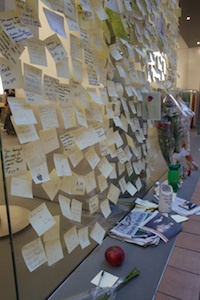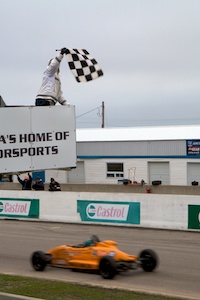

Just a Canadian curious about the world

Today, Rosa and I attended the annual Zombie Walk downtown. It started in the east and ended up on the front lawn of Parliament Hill.
We arrived late, so that limited me to only the Hill for taking photos. I would have liked to take some along the walk too. Additionally because of the late afternoon sun, and the desire to avoid the modern city scape as a background, I was very limited in the angles I could use.
I found a spot just inside the gates, where all of the zombies were entering. It was the best I could do, but once settled in, crouching down low, it actually was a pretty good spot. The low vantage point, looking up at the zombies backlit from the setting sun, it gave an ominous feeling.
There were some excellent costumes. One of the most photographed was the zombie of recently deposed and disposed Colonel Gaddafi of Libya. Also of note were the Lego Minifig zombies.
Some other photos from the Zombiewalk are here: http://gallery.myredbmw.net/v/Events/Zombie2011.
To the dark-haired woman that blew by me on Cresthaven Drive this morning in your SUV,
Get Bent!
You are going to kill some child in my neighbourhood. I think this is the second time you’ve passed me at high-speed on our narrow, winding suburban streets. If I could, I would ensure that your licence is taken away.
No Love,
-me

I have been following the Occupy Wall Street (OWS) protest in New York. I am generally supportive of their aims – to bring awareness of the increasing inequality in America. Additionally, I feel there is a great deal of pent up anger at Wall Street for their contribution to the massive economic chaos of 2008 and the Global Financial Crisis. It not only seemed like those responsible were never taken to justice for their actions, but in many cases they just got richer while being bailed out by tax payers. I am angry that the moral hazard of their risk taking was never addressed.
They were not the only ones of course. The mortgage industry, the credit rating agencies, certain mortgage applicants, and the government all failed together. The impact is still being felt, for example in the on-going Euro crisis.
The contagion that started on Wall Street quickly spread to Europe, through the English banks and the over-leveraged banks in countries like Iceland.
It is true that the taxpayer bailouts included the very same bankers – they pay taxes too. However, as the OWS movement has brought up, the top earners (like the Wall Street financiers) often pay a lower tax rate than their secretaries. This idea spawned the “We are the 99%” movement.
Power in the US resides in the wealth class. The Senators and Representatives and Presidents are typically millionaires. The power of the ultra-wealthy, with few limits to their political contributions, has increased dramatically. Even corporations, thanks to the second-worst Supreme Court decision, can contribute with no limits to political campaigns.
The poor are not being represented. Even the middle class is less and less empowered, despite contributing the majority of the tax base for the US. It’s almost like taxation without representation.
I admit that I don’t understand the Occupy protests in other locations, such as Canada. There are protesters here in Ottawa. In Canada, our financial systems and banking are highly regulated and never got into the same sort of risk taking as Wall Street or Canary Wharf. And Ottawa is not even the business centre of Canada – that’s Toronto and Montreal. And in Canada, the tax rate are significantly higher. I think this is a good balance. I pay around 42% in income tax (even more once the 13% harmonized sales tax is included, even though it is not income tax). Although it is a high rate, I think that it provides a more balanced, civil society. It is one of the privileges of living in one of the best countries in the world.
[Updated Nov 25, 2012: The top 1% in Canada took almost a third of all growth in incomes between 1997 and 2007. I am now more understanding of the Occupy protests in Canada. Canada has inequality that could be addressed.]
In the 1950’s, with one of the greatest boom economies, the top tax rate in the US was 85% and rose to 91% by 1960. The same in Britain – the Beatles were paying 95% when George wrote Taxman. Although that rate might be too high, the ultra-wealthy should contribute to the overall common good. Today, the top tax rate for the ultra-wealthy Americans, according to the Internal Revenue Service, is 18%.
Coming back to the 99% protests, I decided to see where I fit in. I know that as a high-tech worker, I am above the Canadian average. I am in the second highest tax bracket. I found a website http://www.globalrichlist.com/ and input my income. I was flabbergasted to discover that I am in the top 0.7% world wide. I am roughly the 40,000,000th richest person in the world. There are 7 billion people in the world. I was stunned. Am I part of the problem? Am I a bad person?
But that’s the world wealth calculator. I found a separate Canadian calculator, http://www2.macleans.ca/2011/10/25/rank-your-income-where-do-you-stand-compared-to-the-rest-of-canada/. I put the same numbers in and found that I drop well out of the top 1% – Canada is a wealthy country overall and is a member of the G7.
It still left me wondering, “I am doing enough”? I think the answer is yes and no.
No, I do not donate as often as I could. I do donate to causes that are important to me, like diabetes research. I give blood. I give to local charities. And I volunteer my time. But I know, especially when I think about the numbers above, that there are many impoverished people in the world. I’ve been to India and other places where the difference between the First World and the rest of the world is stark.
But, Yes, I do feel that I contribute to the common good. I work for a telecommunications company. I am part of the team building network infrastructures that are used by people around the world to communicate. Although not everyone can afford a phone, it is surprising that even in a poor country like India, over 851 million people have mobile phones – that’s over 70% of the population. Access to information and people can increase socioeconomic development everywhere.
In the end, I guess that makes me feel better.
I have been spending a long time thinking about a logo for my photography business (Ottawa PhotoWorks). I wanted to make sure it was easy to reproduce and easy to see even at small sizes.
I think PhotoWorks has a kind of industrial or steampunk meaning. So I thought it should be something mechanical. I spent a long time thinking about different options before I settled on a idea to combine the circle of a lens with a gear, to merge photography with the industrial feel.
Next, how to create it?
I started by looking through my own photography examples. I have some photos of gears on a steam train, but it was not easy to extract the content from the background (the train itself). I could take a photo of a lens. But together, it would not look quite right. I looked for samples of lenses and gears at other photography sites. I never found anything like what I wanted.
My next attempt was to look for ways to create from stretch using Adobe Illustrator. I first found a tutorial (http://macmerc.com/adobe-illustrator-tip-simple-gears-using-pathfinder-and-the-star-tool/) on creating gear-shapes. It was very easy to do. I created a gear. I did it twice to find the best size and shape.
Next, I needed a texture to make it look more like a gear. I found a second tutorial to add a brushed metal texture (http://vectips.com/tutorials/create-a-brushed-metal-texture/). It was easy too.
The final tutorial was to create a lens shape (http://vector.tutsplus.com/tutorials/illustration/create-an-aperture-style-camera-lens-icon/). This was much more involved, and there was a lot I needed to learn about Illustrator. When I used Illustrator in the past, it was mostly for creating diagrams for charts (dependency diagrams, org charts, software architecture). It took about 2 hours to create the lens.

Finally, I needed to merge the shapes. First I cut the gear in half vertically. I copied this half-gear onto the lens shape. This didn’t work out quite right at first, as the lens was not entirely covered by the gear shape. I had to make another box to create a path that would hide the part of the lens that should be behind the gear. I had to leave a small square in the middle so that the hole in the middle of the gear would show more of the lens.
All together, this project took most of an afternoon. I played the (Blu-Ray) documentary “The Wonder of It All” on my PC while I was creating on the MacBook Pro.
This evening Rosa and I went to see the National Arts Centre Orchestra (NACO).
The opening piece was Vaughan Williams, Fantasia on a Theme by Tallis. It was absolutely enchanting. Very peaceful and yet memorable. I liked it so much that when I got home, I bought it on the iTunes Store. (It is also available to play from the event page http://www2.nac-cna.ca/en/orchestra/event/63 just below the photo of conductor Hannu Lintu).
The second piece was the violin concerto, “Concentric Paths” by Thomas Adés, with soloist Leila Josefowicz. I did not enjoy this modernist work. I found it was too chaotic for my tastes with nothing specific to focus on while listening. The soloist spent 5 minutes before beginning the piece by explaining all the parts to the audience, but that mostly made people impatient.

After intermission, NACO performed Beethoven’s Fifth Sympony (Symphony No. 5 in C minor). It’s a fantastic work. I still prefer the Ninth, but the Fifth is still a magnificent work.
The NACO was conducted by a guest Finnish conductor, Hannu Lintu. I am interested to see the different styles of the conductors we have seen over the past 6 years that Rosa and I have attended concerts together.
Hannu Lintu has an eccentric and energetic style. His motions and gestures were dramatic. He was just so fascinating to watch.

I am sad to hear about the passing of Steve Jobs. But it was not unexpected news. After seeing how thin and weak he appeared at the Apple 2011 Worldwide Developers Conference (WWDC), I had told my co-workers and friends that he would likely not make it to the end of the year. He was just too thin. You could see it in how he walked, like his sneakers were too big for him, and in his energy levels; he didn’t have the same vibrant ebullience.
I have been an Apple owner since 1984. That’s when my parents bought an Apple IIc. Since then, I have been a continuous owner of various Apple computers and will continue to do so into the foreseeable future.
I even programmed on a NeXTstation for the psychology department one summer at Acadia University, although I used standard C, not Objective-C.
Steve was more than just Apple, and Apple is more than just Steve. It’s also the people who make and create the great products makes Apple Apple (and Pixar Pixar). Someone who can turn a vision into a product. Steve produced the vision of course, and had input at every step. But he was surrounded by those fantastic engineers who could implement the designs that he tweaked to perfection.
I’ve greatly admired how Steve could do his presentations. Without a doubt, Steve Jobs did the best keynote speeches and product presentations ever. I have done many presentations in my career, and was never as smooth or practiced.
All people, great or anonymous, will follow this same path. Steve Jobs was a person just like everyone else, no matter how much his will would seem to warp reality.
I have a theory about loss and grief. I think that the feeling one gets, that profound sense of what was lost and cannot be regained, is actually the human brain attempting to cope with its own subconscious awareness of the one-way arrow of time. Normally, we are not aware of this, or are even able to comprehend why time is unidirectional. It’s just the way things are – time moves forward. When dealing with loss, the brain cannot understand this forever forward tic-toc of time. The feeling of loss is our brain not being able to comprehend why we cannot go back in time to when the person was still alive. It’s a very deep feeling, below our conscience, and it is expressed as this vague and painful emotion.
Today I donated blood for the first time. I have wanted to give blood for a long time. Every month or so, Canadian Blood Services (CBS) would hold a donation clinic at the cafeteria at work.
Nothing happens without being proactive, so I called CBS and booked an appointment to sign up to be a donor. I was asked a few questions on the phone when I booked, mostly around what countries I have visited. After going through them all, the attendant agreed that there were no issues and booked me for my first donation.

The clinic was actually a Bloodmobile, which was parked at the Costco building. I arrived a few minutes early. When I entered the bus, I was checked in immediately, then sent into a room at the back of the bus where I could fill out a form in private. After I filled out the form, a nurse went over the form with me, as I had noted a few items, such as when I fainted in Los Angeles. We also reviewed the countries I have visited, and again there were no issues. I was also asked about my vaccinations for an upcoming trip. When I booked the appointment, I was not told that I needed to list my vaccinations too. I could not remember everything, but the nurse and I worked through the list for Tanzania and agreed that I was ok. She also told me that after I return from Tanzania, I will not be able to donate for a full year, due to the malaria risk.
After the paperwork was completed, I was taken to one of the four beds in the front of the bus. I was connected up and I could see a small, clear bag that filled with blood. From that small bag, four tubes were drawn, like the ones used for blood tests. I waited for the next phase when they would start the donation when the nurse stopped by and said I was all done. I was surprised, and so was the woman across the isle. She had been donating since before I lay on the bed. She glanced over at me in shock that I could be done so fast. I didn’t even know there was a second tube I could not see that had already been taking the donation.
I was told I had to wait for 5 minutes before I could leave, and was given a timer. As I sat there, I started feeling cold (that was expected), but I also started feeling a little nauseous. Then I felt lightheaded. I thought it was minor at first, but it started getting worse. I started feeling like I did in Los Angeles before I passed out. This was not good. I could see the timer counting down; nearly 5 minutes had elapsed, so I waited until the nurse returned instead of raising an alarm.
When she returned, she could see I was in some distress. She asked me how I felt, and I explained. She set the bed down flat and I laid down. Another nurse came by and inquired about my state. The first nurse replied that it was my first time, and the second nurse nodded knowingly.
I was brought a bottled water and an orange juice. Even though I thought I had drank enough before my appointment, I could see that it was not, and that I did not have enough sugar. Next time I’ll know better and be prepared.
After a few short minutes I felt much better and could get up. I walked to the front door of the bus and sat down. There were Oreo cookies there, so I had some – it’s been years since I had some and they were good! Feeling much better, I got in my car and headed to work.
[Updated Oct 31, 2011: One reason I pushed myself to donate blood was because I had a friend and former colleague who was diagnosed with Leukemia. Sadly, Craig passed away on the weekend. Last week, before this news, I began looking into bone marrow donation.]
I was working as an assistant clerk again on the weekend, this time with Roger Falconer, for the CASC-OR Celebration Weekend at Mosport.
I met Roger Saturday morning on mock grid. The other assistants and the group leads (chief course marshal (CCM), mock grid, operations, etc) made sure everyone was in place, and then Roger, Jeff (Operations) and I took a hot lap around the track. Roger said he was checking that everyone was in the correct place and that the tire walls were ok. He specifically noted that the tires had to be in a particular geometry for the formula cars.
Once in the control tower, he assigned me to handle the Request for Actions. This was a great deal of responsibility, although it was not as active as being one of the radio dispatchers like I did at the DAC weekend. A Request for Action (RFA) is where an incident is reported to the clerk that may involve a breach of the racing regulations (such as a pass under yellow) or driving misbehaviour. When a report comes in, I was then to gather enough data to assess of the report should be forwarded to the Stewards of the event. This could involve requesting a written report from the person observing the incident (a flag marshal for a yellow flag report, or perhaps the starter for a jumped start), then request that the drivers report to the Clerk. When the drivers arrived, I would try to first interview the person who impacted by the incident (i.e. the person who was passed), then interview the accused. In each case, I tried to word my questions in an open way to get the drivers to volunteer information rather than being lead by my questions.
Then I would fill out the RFA report and would hand the report and other written documentation to the Stewards and tell them that both drivers were available.
There were two pass under yellows and one jump-start that I had to deal with. One of the incidents was dropped, but the other two concluded with penalties assessed against the drivers.

I also helped with a very unusual issue brought by one of the crew. The car had never run at Mosport before, so they did not know what class the car should be in. After reading the rules, the team thought they would have until after qualifying to set their class – with the presumption that they could change their class up until the end of qualifying without penalty. However, once they changed their class (to align with their qualifying time), the grid sheet put them at the back of the grid because of the class change. I worked with Roger, the stewards, timing and the regional Race Director to review all of the rules and try to find the best solution. I also interfaced with the team crew chief, keeping him informed of the progress and also trying to impartially convey his concerns to the other officials. In the end, because the rule was a bit vague, everyone agreed that he would be gridded by his qualifying time and not be penalized for the class change.
The Celebration weekend is the last regional race of the year. There are no more race events until May 2012 – a long layover. It’s one of the downsides to living in Canada.